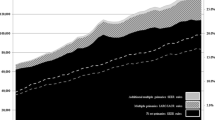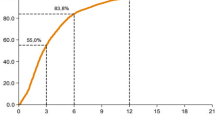Abstract
Objective: To determine breast cancer case counts, on a given data set, using both Surveillance, Epidemiology, and End Results (SEER) program and International Agency for Research on Cancer (IARC) multiple primary coding rules and to describe differences, if any, by age at diagnosis, histology, stage at diagnosis, laterality, and grade. Methods: SEER and IARC multiple primary coding rules were applied to a dataset provided by the North American Association of Central Cancer Registries. Only registries whose data met high quality data standards for the time period studied (1994–1998) and whose permission was obtained were included. Percentage differences were calculated using IARC counts as the base. Results: Using IARC multiple primary rules resulted in 2.4% fewer cases. Among females, the highest percent changes by category were: age group – 80–84 year-olds (3.4%); histology – inflammatory breast cancer (4.6%); stage – distant (3.1%); grade – well differentiated (3.0%). Among males, the highest percent changes by category were: age group – 80–84 year-olds (1.7%); histology – for intraductal and lobular breast carcinoma in combination (4.8%); stage – distant (3.0%); grade – well differentiated (1.8%). Overall differences were generally unaffected when examined by laterality. Conclusion: Breast cancer case counts are dependent on the multiple primary coding rules used.
Similar content being viewed by others
References
Fritz A, Ries L, eds. (1998) SEER Program Code Manual, 3rd edn. Surveillance, Epidemiology, and End Results (SEER) Program. National Cancer Institute. National Institutes of Health (NIH); SEER Publication No. T-894; NIH Publication No. 98-1999. Bethesda, Maryland: National Cancer Institute.
Parkin DM, Chen VW, Ferlay J, Galceran J, Storm HH, Whelan SL (1994). Comparability and Quality Control in Cancer Registration. International Agency for Research on Cancer (IARC) Technical Publications No. 19. Lyon: IARC.
Percy C, Van Holten V, Muir C, eds. (1980) International Classification of Diseases for Oncology, 2nd Edn. Geneva: World Health Organization.
Hotes JL, Wu XC, McLaughlin CC, et al. eds. (2003) Cancer in North America, 1996-2000. Vol. 1: Incidence. Springfield IL: North American Association of Central Cancer Registries.
Parkin DM, Plummer M (2002) Comparability and quality of data. In: Parkin DM, Whelan SL, Ferlay J, Teppo L, Thomas DB, eds. Cancer Incidence in Five Continents, Vol. VIII. International Agency for Research on Cancer (IARC) Scientific Publications No. 155. Lyon: IARC, p. 57.
Author information
Authors and Affiliations
Corresponding author
Rights and permissions
About this article
Cite this article
Hotes, J.L., Ellison, L.F., Howe, H.L. et al. Variation in breast cancer counts using SEER and IARC multiple primary coding rules. Cancer Causes Control 15, 185–191 (2004). https://doi.org/10.1023/B:CACO.0000019505.97836.7d
Issue Date:
DOI: https://doi.org/10.1023/B:CACO.0000019505.97836.7d




